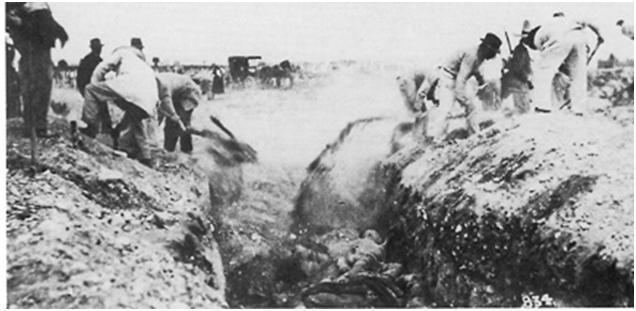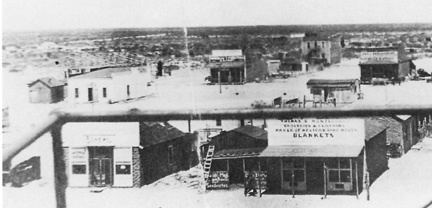484 353 | Date 9 March 1916 | |
 | ||
90+ soldiers killed~13 wounded6 captured 7 soldiers killed15 civilians killed Similar Mexican Revolution, Pancho Villa Expedition, Battle of Carrizal, Battle of Ciudad Juárez, Border War | ||
The Battle of Columbus (Burning of Columbus or the Columbus Raid), March 9, 1916, began as a raid conducted by Pancho Villa's Division of the North on the small United States border town of Columbus, New Mexico, located 3 miles north of the border. The raid escalated into a full-scale battle between Villistas and the United States Army. Villa himself led the assault, only to be driven back into Mexico by elements of the 13th Cavalry Regiment stationed at the town. The attack angered Americans and President Woodrow Wilson ordered the Punitive Expedition in which the US Army invaded Mexico in an unsuccessful attempt to capture General Villa.
Contents

Battle

After the 1915 Battle of Celaya, where Villa sustained his greatest defeat, the Division of the North was in shambles, wandering around northern Mexico foraging for supplies. Lacking the military supplies, money, and munitions he needed in order to successfully pursue his war against Mexican President Venustiano Carranza, Villa planned the raid and camped his army of an estimated 500 horsemen outside of Palomas 6 miles south of the border. Columbus, located 3 miles north of the border was populated by about 500 Americans and about as many Mexicans that fled north from the advancing Villistas. The reasons for the raid have never been established with any certainty. An American kidnap victim travelling with the raiding party, Maude Hauke Wright, said that Villa came with 3000 men and 6000 horses and attacked Columbus with 1500. She was told that Villa thought that by provoking America into invading Mexico it would cause the Germans and Japanese to intervene.

At their camp, Villa and his men waited for his returning patrols. After the patrols told him that only about thirty soldiers garrisoned Columbus, Villa moved north and crossed the border about midnight. In actuality the garrison came from the 13th Cavalry Regiment usually stationed at Camp Furlong, adjacent to Columbus, and consisted of the headquarters troop, machine gun troop, and four of the seven rifle troops deployed to patrol the border, totaling in all 12 officers and 341 men, of which approximately 270 were combat troops.
Villa divided his force into two columns, most of which approached the town on foot, and launched a two-pronged attack on the town in the dark early on March 9. Most of the town's population was asleep, along with most of the garrison, when they entered Columbus from the west and southeast at 04:15, shouting "¡Viva Villa! ¡Viva México!" and other phrases. The townspeople awoke to an army of Villistas burning their settlement and looting their homes. The commander of the 13th Cavalry was Colonel Herbert Jermain Slocum. He had been advised the day before, from three conflicting reports from Mexican sources, that Villa and his soldiers were on the move, possibly against Columbus. One warning was given by Juan Favela, the foreman of a ranch near Palomas (3 miles south in Mexico), who had seen them headed north the day before the attack. Amidst many such reports that had proved false, the warning was ignored as unreliable, although the troop at the Border Gate was reinforced and all three troops in the field were ordered to step up patrolling of the 65-mile long border. However, U.S. soldiers were forbidden to reconnoiter inside Mexico and thus unable to check reports of Villa's whereabouts.

Despite being taken by surprise, the Americans quickly recovered. Soon after the attack began, 2nd Lt. John P. Lucas, commanding the 13th Cavalry's machine gun troop, made his way barefooted and alone from his quarters to the camp's barracks. He organized a hasty defense around the camp's guard tent, where his troop's machine guns were kept under lock, with two men and a Hotchkiss M1909 Benét–Mercié machine gun. He was soon joined by the remainder of his unit and 30 troopers armed with M1903 Springfield rifles led by 2nd Lt. Horace Stringfellow, Jr. The troop's four machine guns fired more than 5,000 rounds apiece during a 90-minute fight, their targets illuminated by fires of burning buildings. In addition, many of the townspeople were armed with rifles and shotguns. Many residents took refuge in the two story brick schoolhouse.
Villa's men looted and burned many houses, fighting civilians that were defending their homes. It is not known if Villa was with the raiding party at any time. However, it is known that during most of the battle, Villa, his commanders, and about two dozen other men took up position on Cootes hill overlooking Columbus where they could observe the action and where some of Villa's men acted as sharpshooters to fire upon the town. The Villistas fought the pursuing American troops and civilians until a bugler sounded the order to retreat. Major Frank Tompkins, commanding the regiment's 3rd Squadron and acting as its executive officer, asked and received permission from Slocum to pursue the withdrawing Mexicans. Disregarding the rules of engagement, he led two troops 15 miles into Mexico in pursuit of a force approximately six times the size of his, engaged Villa's rear guard four times, and inflicted some losses on them before withdrawing back across the border after running low on ammunition and water. Tompkins was awarded the Army Distinguished Service Medal and the Distinguished Service Cross in 1918 for this action.
Aftermath
On March 9, 1916, after the attack, President Woodrow Wilson appointed Newton Diehl Baker, Jr. to fill the vacant position of United States Secretary of War.
In spite of Villa proclaiming that the raid was a success by evidence of captured arms and equipment from the camp, which included over 300 rifles and shotguns, 80 horses, and 30 mules, the raid was a tactical disaster for him with ill-afforded casualties of 90 to 170 dead from an original force that had numbered 484 men, including at least 63 killed in action and at least seven more who later died from wounds during the raid itself. Of those captured during the raid, seven were tried; of those, one sentence was commuted to life in prison; and six were convicted and executed by hanging. Two were hanged on June 9, 1916; four were hanged on June 30, 1916. The sixty-three dead Villa soldiers that were left behind in Columbus following the raid were dragged south of the stockyards, soaked with kerosene and burned.
The United States government wasted no time in responding. National Guard units from around the nation were called up and by the end of August 1916 over 100,000 troops were on the border. The Battle of Columbus resulted in the creation of the Punitive Expedition led by General John J. Pershing to track down and capture or kill Villa or disperse the attackers. In the operation, the Army used Curtiss Jenny airplanes for reconnaissance and trucks to carry supplies (both firsts for the Army). They scoured portions of northern Mexico for six months but Villa was not found. In January 1917, with the United States likely to enter World War I soon, and under intense diplomatic pressure from the Mexican government, these troops were withdrawn from Mexico.
In commemoration of Pancho Villa's attack on Columbus, the State of New Mexico Parks Commission established Pancho Villa Historical Park and its museum in Columbus, near Cootes hill across the Palomas road from the site of Camp Furlong.
